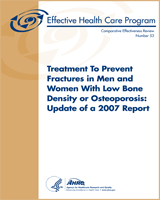NCBI Bookshelf. A service of the National Library of Medicine, National Institutes of Health.
Crandall CJ, Newberry SJ, Diamant A, et al. Treatment To Prevent Fractures in Men and Women With Low Bone Density or Osteoporosis: Update of a 2007 Report [Internet]. Rockville (MD): Agency for Healthcare Research and Quality (US); 2012 Mar. (Comparative Effectiveness Reviews, No. 53.)
This publication is provided for historical reference only and the information may be out of date.

Treatment To Prevent Fractures in Men and Women With Low Bone Density or Osteoporosis: Update of a 2007 Report [Internet].
Show detailsCompared to the evidence available at the time of our prior report, additional evidence has emerged to clarify differences in anti-fracture efficacy between pharmacologic agents used to treat osteoporosis (e.g. hip fracture reduction only demonstrated for bisphosphonates and denosumab), and even among bisphosphonates (e.g. hip fracture reduction demonstrated for zoledronic acid, alendronate, and risedronate, but not ibandronate) among postmenopausal women with established osteoporosis. Nonetheless, data are thin regarding comparative effectiveness between different agents and several concerns remain:
- Whom should we treat? What is the balance of benefits and harms for postmenopausal women without established osteoporosis? The existing evidence shows that the strength of evidence for a benefit of treatment (in terms of fracture risk reduction) is low to moderate for postmenopausal women with osteopenia and without prevalent fractures and for men compared with postmenopausal women with established osteoporosis for whom the evidence is high. Given the established adverse events associated with treatment, and newly identified risks such as atypical subtrochanteric femur fractures, the question of whom to treat outside of postmenopausal women with established osteoporosis is perhaps less clear now than it was before. One way forward is to move away from BMD-based measures of risk and conduct trials that use a risk assessment- based method of identifying patients, such as the FRAX. Such risk assessment methods can incorporate other variables known to be associated with risk of fracture that go beyond BMD. Re-analysis of existing trials should assess whether application of FRAX estimates post-hoc allows for identification of subgroups of subjects at higher or lower risk than the typical subjects.
- How long should we treat? The evidence base here is especially thin – the existing evidence is really just one trial, and one post hoc analysis of that trial, which suggests that treatment beyond five years with alendronate does not have a benefit in nonvertebral fracture risk reduction, except possibly in women with low BMD at baseline. Should treatment be for three years, four years, five years, or more? And what patient-level factors are important (such as the aforementioned low BMD at baseline) in terms of determining length of treatment? “Drug holidays” have been advocated by some clinicians – what are the benefits and harms of such holidays? When should they be timed? For how long should the “holiday” last? Could the efficacy of drug holidays vary according to pharmacologic profiles (e.g. route or frequency of administration) of the various bisphosphonates? And should all therapies be subject to a holiday, a point raised by a recent basic science analysis of denosumab?482
- For people who are good candidates for treatment, how can we improve adherence? There is a moderate to high level of evidence that adherence is commonly poor, and that poor adherence is associated with worse fracture outcomes. This work needs to consider not just the dosing barriers to adherence, but the other factors reported in the evidence (e.g., side effects, knowledge about osteoporosis, and cost.) The role of newer therapies administered once or twice yearly in improving adherence and persistence, and their cost-effectiveness, should be investigated.
- For patients on treatment, should we monitor changes in BMD, and if so, how often? While no studies have examined explicitly the benefits and harms of BMD monitoring while on therapy, the practice remains popular, although the rationale for it is not clear. Post hoc analyses of trials of treatment show that changes in BMD while on treatment only modestly predict fracture risk reduction, and even patients whose BMD declines while on treatment have statistically significant reductions in fracture risk.
- What is the comparative effectiveness of sequential treatment (following treatment with one class of agent by treatment with another)? We identified no clinical trials on the use of sequential treatment, although anecdotal evidence suggests that it is done in clinical practice (either intentionally, in the belief that it is superior to continued treatment with a single agent, or because some individuals do not respond to or cannot tolerate a particular agent). Thus studies are needed to assess the effectiveness of sequential regimens.
- We need to remain vigilant for possible rare side effects. The identification – since our prior 2007 report – of an association between bisphosphonate use and atypical subtrochanteric fractures of the femur demonstrates the importance of the continuing need for surveillance, as this identification was not widely reported until after well more than a decade of widespread use.
- Future Research - Treatment To Prevent Fractures in Men and Women With Low Bone ...Future Research - Treatment To Prevent Fractures in Men and Women With Low Bone Density or Osteoporosis: Update of a 2007 Report
- Introduction - Treatment To Prevent Fractures in Men and Women With Low Bone Den...Introduction - Treatment To Prevent Fractures in Men and Women With Low Bone Density or Osteoporosis: Update of a 2007 Report
- Discussion - Treatment To Prevent Fractures in Men and Women With Low Bone Densi...Discussion - Treatment To Prevent Fractures in Men and Women With Low Bone Density or Osteoporosis: Update of a 2007 Report
- Caenorhabditis elegans protein of unknown function WSN domain-containing protein...Caenorhabditis elegans protein of unknown function WSN domain-containing protein (Y51A2B.6), partial mRNAgi|1845979030|ref|NM_001029086.5|Nucleotide
- Calponin-homology (CH) domain-containing protein [Caenorhabditis elegans]Calponin-homology (CH) domain-containing protein [Caenorhabditis elegans]gi|808357684|ref|NP_001294368.1|Protein
Your browsing activity is empty.
Activity recording is turned off.
See more...